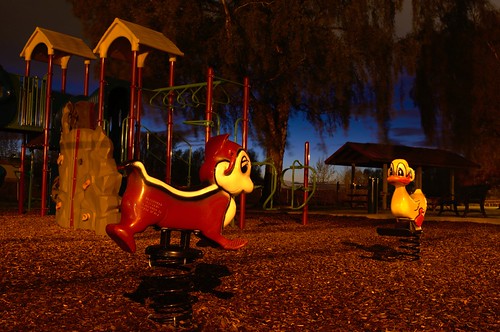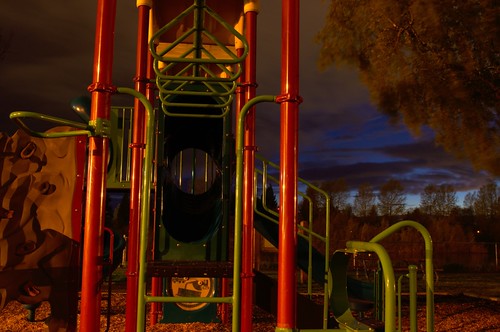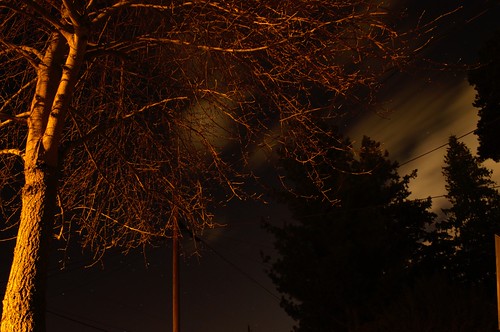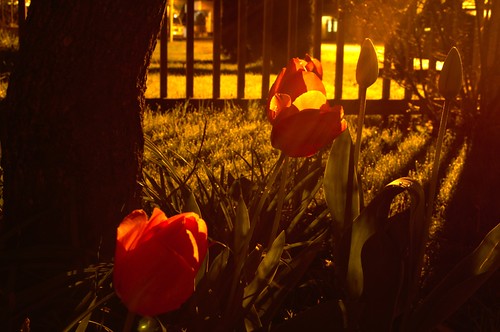City parks, and the playground toys they typically contain, are usually bustling with activity and the laughter of little ones enjoying the out doors. Not so at night, which gave me an idea that the playground equipment might make an interesting long exposure photo, as many long exposure photographs have an entirely different look than a daylight photo - a look that can often have an almost post-apocalyptic feel to it.
The look is not quite what I expected, though the look is still vastly different than daylight hour photos. This project was definitely a fun experiment and one I am very happy with the results and also likely to add to sometime in the future. On this photo excursion, I found that the ambient light makes a huge difference with these types of photos, not
only on how long you will need to leave the shutter open, but also on
the overall look and feel of the final image - especially in the color
tones. The ones that I found worked the best were taken long enough
after sunset for any last lingering rays of sunlight to have passed, leaving street lamps and exterior lighting of any surrounding businesses as the only light sources. Below are my favorites from the shoot:
I also took a couple of long exposure shots in my back yard (see long exposure of tulips), and below is one of a not yet leafing tree with stars and clouds visible.
Two take-away tidbits I figured out while taking these pictures: First, 30 seconds feels like an excruciatingly long wait standing in the dark on an empty playground waiting for a shutter to finally close. Second: bring a powerful enough light to aid with focusing if there is not enough ambient light. A small LED light just doesn't have enough range for auto focus to work or allow you to see for manual focus. Also, with these types of shots you will find a good remote shutter release is worth every penny.
Blessings,
Jesse
My blog dedicated to my journey through the art of photography, learning, experimenting and exploring the beauty of God's creation through the viewfinder of a camera.
Monday, April 22, 2013
Saturday, April 20, 2013
In Camera Black & White vs. Software Conversion
Black and white photography was never something I pursued personally - appreciated yes, but until recently not something I had a personal interest in producing. That all changed after being the adviser for a middle school photography club after the black and white assignment. Participating with the students sparked an interest in Black and White photography for me, and I will do a few conversions here and there through out any given year. I also have some ideas for intentionally setting out to create an image meant to be black and white as opposed to converting some of my collection as an after thought for images that look like they will work well as a monochrome.
Now when we look at modern digital cameras, we will always find a dedicated black and white mode where the camera will do all the monochrome processing. This may make it quick and easy to create black and white photos, but this does come with two big drawbacks if you select this mode to create a black and white photograph. The first being the loss of any color information (unless you are shooting with a DSLR on raw or raw+jpg). This may seem trivial, especially if you are looking to create a black and white work, but when going this route you just may loose an image that would be better had the color information been retained. Number two is a lack of control with the overall final image, you may be able to fine tune a little bit with software but the camera has pretty much set the foundation.
When it comes to software conversion, the big drawback is the added time it will take to do the conversion. While its true that you can have some base presets in most software, these presets would typically be image specific and won't always produce the look you are trying to achieve with other images. It may work as a good baseline, but you will likely need to do some more fine tuning. Really a small trade off for having full creative control over you final product.
So, with that in mind, below are some comparisions of an in camera black and white next to an image converted in software. To set up this shot, I placed my camera on a tripod and set it for a monochrome image on RAW+JPG. This way, I will have the full color information in the RAW file as well as the in camera processed monochrome image as a JPG.
For reference and comparison, 1st we have the color image:
Next, we have the in camera processed image:
Then, a black & white converted with the GIMP program:
And lastly, one converted with Darktable:
When it comes to the final product, I think you get much better results with the software conversion and that is what I recommend. As a side bonus of having a better finished image and full control over the look, you also still retain your color photograph, giving you the best of both worlds.
Blessings,
Jesse
Now when we look at modern digital cameras, we will always find a dedicated black and white mode where the camera will do all the monochrome processing. This may make it quick and easy to create black and white photos, but this does come with two big drawbacks if you select this mode to create a black and white photograph. The first being the loss of any color information (unless you are shooting with a DSLR on raw or raw+jpg). This may seem trivial, especially if you are looking to create a black and white work, but when going this route you just may loose an image that would be better had the color information been retained. Number two is a lack of control with the overall final image, you may be able to fine tune a little bit with software but the camera has pretty much set the foundation.
When it comes to software conversion, the big drawback is the added time it will take to do the conversion. While its true that you can have some base presets in most software, these presets would typically be image specific and won't always produce the look you are trying to achieve with other images. It may work as a good baseline, but you will likely need to do some more fine tuning. Really a small trade off for having full creative control over you final product.
So, with that in mind, below are some comparisions of an in camera black and white next to an image converted in software. To set up this shot, I placed my camera on a tripod and set it for a monochrome image on RAW+JPG. This way, I will have the full color information in the RAW file as well as the in camera processed monochrome image as a JPG.
For reference and comparison, 1st we have the color image:
Next, we have the in camera processed image:
Then, a black & white converted with the GIMP program:
And lastly, one converted with Darktable:
When it comes to the final product, I think you get much better results with the software conversion and that is what I recommend. As a side bonus of having a better finished image and full control over the look, you also still retain your color photograph, giving you the best of both worlds.
Blessings,
Jesse
Monday, April 15, 2013
Long Exposure of Tulips at Night
I had some free time and had been wanting to explore some long exposure night photography for a while now. And after taking the shots I had been mulling over in my head for a while, I came across a weekly challenge post on Digital Photography School - a photo site I will occasionally frequent.
The weekly challenge was titled "Seasonal" and being on the long exposure train of thought at the time - I thought it could make an interesting photo to do a long exposure of some tulips. This would fit into the topic and made for an easy shot to get with out wandering too far in the cold night that was approaching midnight (though closer to 11:00 still).
It was a fun shot to take, and one I am sure not many people do. The glow from the nearby street light and the resulting colors sure presents a look you wouldn't normally see when dealing with photographs of flowers. A selection of the other night photos I took that evening will be following in a post to come, stay tuned.
Blessings,
Jesse
The weekly challenge was titled "Seasonal" and being on the long exposure train of thought at the time - I thought it could make an interesting photo to do a long exposure of some tulips. This would fit into the topic and made for an easy shot to get with out wandering too far in the cold night that was approaching midnight (though closer to 11:00 still).
It was a fun shot to take, and one I am sure not many people do. The glow from the nearby street light and the resulting colors sure presents a look you wouldn't normally see when dealing with photographs of flowers. A selection of the other night photos I took that evening will be following in a post to come, stay tuned.
Blessings,
Jesse
Wednesday, April 10, 2013
In Camera High ISO Noise Reduction Comparison
With modern camera's more is always better, or rather more is almost always the trend when it comes to specifications. ISO ratings are no exception, as new cameras push the available ISO settings higher and higher with each new model. The higher ISO options help with low light but come with a big downfall in the form of higher concentrations of noise present in the resulting photos. To help offset this, many cameras offer a High ISO Noise Reduction option, and photography development software also offers noise reduction modules . The downside to noise reduction can be a loss of image quality as the algorithms tend to soften the image in the process.
For an experiment I set my Nikon D5100 to ISO 6400, placed it on a tripod and took four successive photos. The first with High ISO Noise Reduction set too off, the next set to low, then medium and finally high. Below are crops of the resulting images for comparison to see how the various levels of noise reduction look in a final image. I also used Darktable to run noise reduction and some slight sharpening on the image with noise reduction set to off for some additional comparison (this image is labeled ISO 6400 DT).
Quality wise, I think the low and medium strike a good balance. My approach so far has been to leave my camera on low reduction, and then use Darktable to do some additional noise reduction and/or sharpening when needed. I have been very happy with the results from this setup when I have needed it.
How about you? Do you find a particular noise reduction setting gives better results balancing quality and noise reduction than others?
Blessings,
Jesse
For an experiment I set my Nikon D5100 to ISO 6400, placed it on a tripod and took four successive photos. The first with High ISO Noise Reduction set too off, the next set to low, then medium and finally high. Below are crops of the resulting images for comparison to see how the various levels of noise reduction look in a final image. I also used Darktable to run noise reduction and some slight sharpening on the image with noise reduction set to off for some additional comparison (this image is labeled ISO 6400 DT).
Quality wise, I think the low and medium strike a good balance. My approach so far has been to leave my camera on low reduction, and then use Darktable to do some additional noise reduction and/or sharpening when needed. I have been very happy with the results from this setup when I have needed it.
How about you? Do you find a particular noise reduction setting gives better results balancing quality and noise reduction than others?
Blessings,
Jesse
Subscribe to:
Posts (Atom)













